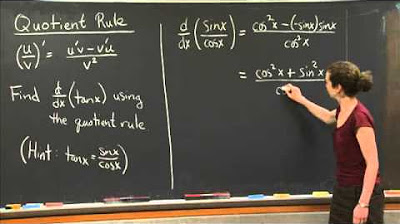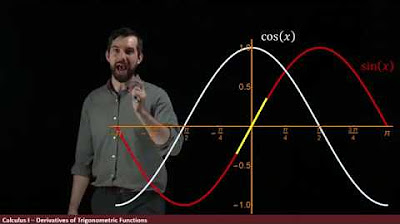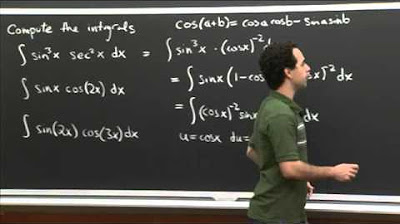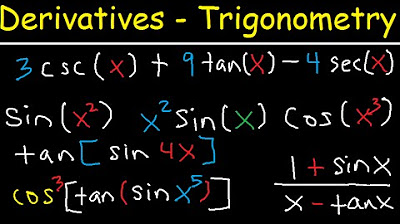Derivative of Sine and Cosine Functions | Calculus
TLDRThis lesson delves into the derivatives of sine and cosine functions, highlighting the fundamental relationships between these trigonometric functions and their derivatives. The derivative of sine x is shown to be cosine x, and the derivative of cosine x is negative sine x. The application of the constant multiple rule is demonstrated through various examples, including the differentiation of expressions like 4 sine x, 8 cosine x, and more complex combinations. The lesson also presents a rigorous proof of the derivative of sine x using the limit definition of a derivative and trigonometric identities, ultimately reinforcing the connection between calculus and trigonometry.
Takeaways
- 📚 The derivative of sine (sin) x is cosine (cos) x.
- 📚 The derivative of cosine (cos) x is negative sine (-sin) x.
- 📈 Using the constant multiple rule, the derivative of 4 sin x is 4 cos x.
- 📈 Similarly, the derivative of 8 cos x is -8 sin x.
- 🔢 For the function 3 cos x - π sin x, the derivative is -3 sin x - π cos x by applying the constant multiple rule and sum/difference formulas for trigonometric functions.
- 📝 When finding the derivative of sin x/5, rewrite the expression as (1/5) sin x and use the constant multiple rule to get (1/5) cos x.
- 💡 To prove that the derivative of sin x (f'(x)) is cos x, use the limit definition of a derivative, f'(x) = lim(h->0) [f(x+h) - f(x)]/h.
- 📊 Apply sum and difference formulas for sine and cosine to simplify the expression for the derivative of sin x.
- 🌟 Utilize the trigonometric limits: lim(x->0) (sin x)/x = 1 and lim(x->0) (1 - cos x)/x = 0 in the proof of the derivative of sin x.
- 🎓 Understanding the limit properties of trigonometric functions is crucial for differentiating trigonometric expressions.
- 📌 The process of finding derivatives of trigonometric functions involves a combination of the constant multiple rule, sum/difference formulas, and limit properties.
Q & A
What is the derivative of the sine function with respect to x?
-The derivative of the sine function with respect to x is the cosine function, denoted as d/dx(sine x) = cosine x.
What is the derivative of the cosine function with respect to x?
-The derivative of the cosine function with respect to x is the negative sine function, denoted as d/dx(cosine x) = -sine x.
How do you find the derivative of 4 times sine x?
-Using the constant multiple rule, the derivative of 4 times sine x is 4 times the derivative of sine x, which is 4 times cosine x. So, the derivative is 4 cosine x.
How do you find the derivative of 8 times cosine x?
-Using the constant multiple rule, the derivative of 8 times cosine x is 8 times the derivative of cosine x, which is 8 times negative sine x. Thus, the derivative is -8 sine x.
What is the derivative of 3 times cosine x minus pi times sine x?
-The derivative of the expression 3 cosine x - pi sine x is found by applying the constant multiple rule to each term separately. The derivative of 3 cosine x is -3 sine x (since the derivative of cosine x is -sine x), and the derivative of pi sine x (with pi as a constant) is pi times the derivative of sine x, which is pi cosine x. Combining these, the derivative of the entire expression is -3 sine x - pi cosine x.
What is the derivative of sine x divided by 5?
-Rewriting sine x divided by 5 as (1/5) times sine x, we apply the constant multiple rule. The derivative of (1/5) sine x is (1/5) times the derivative of sine x, which is (1/5) cosine x. So, the derivative is cosine x divided by 5.
How can we prove that the derivative of sine x is cosine x?
-We can prove this by using the limit definition of a derivative. The derivative of a function f at x, denoted as f'(x), is the limit as h approaches 0 of [f(x + h) - f(x)] / h. For f(x) = sine x, we substitute and get [sine (x + h) - sine x] / h. Using the sum and difference formulas for sine, we simplify this expression and apply the special trigonometric limits to show that the limit as h approaches 0 of this expression is cosine x, thus proving that the derivative of sine x is indeed cosine x.
What are the two special trigonometric limits mentioned in the script?
-The two special trigonometric limits mentioned are: the limit as x approaches 0 for sine x / x is equal to 1, and the limit as x approaches 0 for (1 - cosine x) / x is equal to 0.
How do the sum and difference formulas for sine and cosine help in differentiating trigonometric functions?
-The sum and difference formulas for sine and cosine are essential in simplifying the expressions we get when differentiating trigonometric functions. They allow us to break down complex terms into simpler components, which can then be differentiated using the basic rules of differentiation. For example, when differentiating sine (x + h), we use the sum formula for sine to express it as sine x cosine h + cosine x sine h, which can then be differentiated term by term.
What is the constant multiple rule, and how is it applied in differentiation?
-The constant multiple rule states that the derivative of a constant multiplied by a function is the constant multiplied by the derivative of that function. This rule is applied in differentiation by separating the constant from the variable function, finding the derivative of the function alone, and then multiplying the result by the constant. For example, the derivative of 4 sine x is found by first recognizing sine x's derivative as cosine x and then multiplying it by the constant 4, resulting in 4 cosine x.
Why is it important to know the limit definition of a derivative when working with trigonometric functions?
-The limit definition of a derivative is fundamental because it provides the formal definition of a derivative and is particularly useful when dealing with more complex functions like trigonometric functions. It allows us to precisely define and calculate the rate of change at a specific point, which is crucial for understanding the behavior of the function. In the context of the script, using the limit definition helps in proving that the derivative of sine x is cosine x, which is a key concept in calculus and trigonometry.
Outlines
📚 Derivatives of Sine and Cosine Functions
This paragraph introduces the concept of derivatives of sine and cosine functions. It explains that the derivative of sine x is cosine x and the derivative of cosine x is negative sine x. The paragraph then presents two problems to apply this knowledge: finding the derivative of 4 sine x and 8 cosine x. By using the constant multiple rule, the solutions are derived as 4 cosine x and negative 8 sine x, respectively. Additionally, the paragraph provides further examples to practice, such as finding the derivative of three cosine x minus pi sine x and differentiating sine x divided by five. The explanation emphasizes the importance of understanding the constant multiple rule and the sum and difference formulas for sine and cosine in solving these problems.
🔢 Proof of Derivative of Sine as Cosine
This paragraph delves into the proof that the derivative of the function f(x) = sine x is indeed cosine x. It uses the limit definition of a derivative, which involves calculating the limit as h approaches zero of the expression (f(x+h) - f(x))/h. By substituting f(x) with sine x and applying the sum and difference formulas for sine, the expression is simplified. The paragraph then rearranges and separates the terms to handle the limit more effectively. Utilizing two key trigonometric limits, the limit of sine h/h as h approaches zero (which is one) and the limit of (1 - cosine x)/x as x approaches zero (which is zero), the proof concludes that the derivative of sine is cosine. This detailed explanation reinforces the understanding of the relationship between sine and cosine functions and their derivatives.
📑 Additional Information
This paragraph, though brief, serves as a placeholder for additional content that may follow the detailed explanations and proofs provided in the previous paragraphs. It acknowledges the existence of more information to be covered, hinting at further exploration of the topic.
Mindmap
Keywords
💡Derivatives
💡Sine Function
💡Cosine Function
💡Constant Multiple Rule
💡Sum and Difference Formulas
💡Limit Definition
💡Trigonometric Limits
💡Differentiation
💡Trigonometric Functions
💡Rate of Change
Highlights
The lesson focuses on the derivatives of sine and cosine functions.
The derivative of sine x is cosine x.
The derivative of cosine x is negative sine x.
The derivative of 4 sine x is 4 cosine x using the constant multiple rule.
The derivative of 8 cosine x is negative 8 sine x.
The derivative of three cosine x minus pi sine x is negative 3 sine x minus pi cosine x.
The derivative of sine x divided by five is one-fifth cosine x or cosine x divided by 5.
To prove that the derivative of sine x is cosine x, the limit definition of a derivative is used.
The limit definition of a derivative involves the expression (f(x+h) - f(x))/h as h approaches 0.
Sine and cosine sum and difference formulas are essential for differentiating trigonometric functions.
The limit as h approaches 0 for sine h/h is equal to 1.
The limit as h approaches 0 for (1 - cosine x)/x is equal to 0.
These two special trigonometric limits are crucial for proving the derivative of sine is cosine.
The derivative of sine x is equal to cosine x, which is a fundamental result in calculus.
The lesson provides a clear and structured approach to understanding the derivatives of trigonometric functions.
Practical examples are used to illustrate the application of the constant multiple rule in differentiation.
The lesson demonstrates the process of differentiating composite trigonometric expressions.
Understanding the limit definition of a derivative is crucial for advanced calculus concepts.
Transcripts
Browse More Related Video

Quotient Rule | MIT 18.01SC Single Variable Calculus, Fall 2010

The derivative of Trigonometric Functions

Trig Integral Practice | MIT 18.01SC Single Variable Calculus, Fall 2010

Derivative of Inverse Trig Functions via Implicit Differentiation

Derivatives of Trigonometric Functions - Product Rule Quotient & Chain Rule - Calculus Tutorial

Maclaurin series of sin(x) | Series | AP Calculus BC | Khan Academy
5.0 / 5 (0 votes)
Thanks for rating: